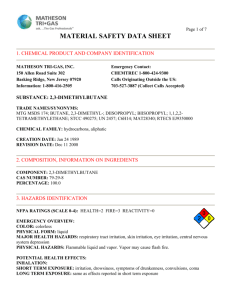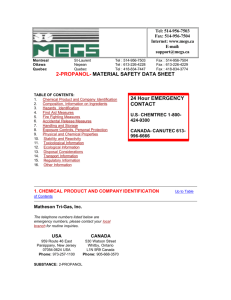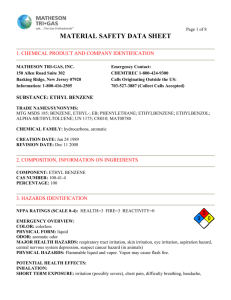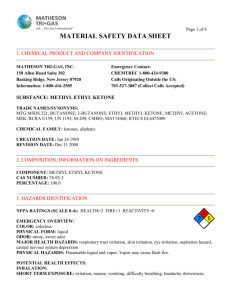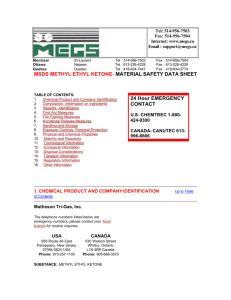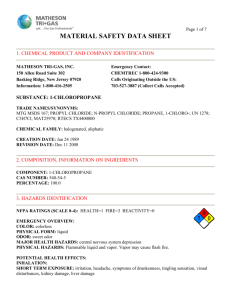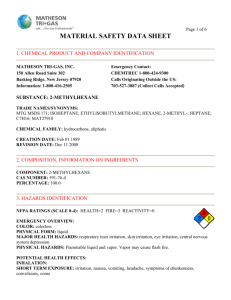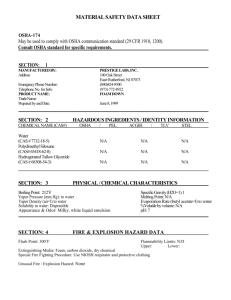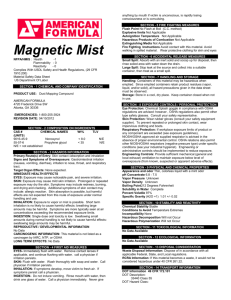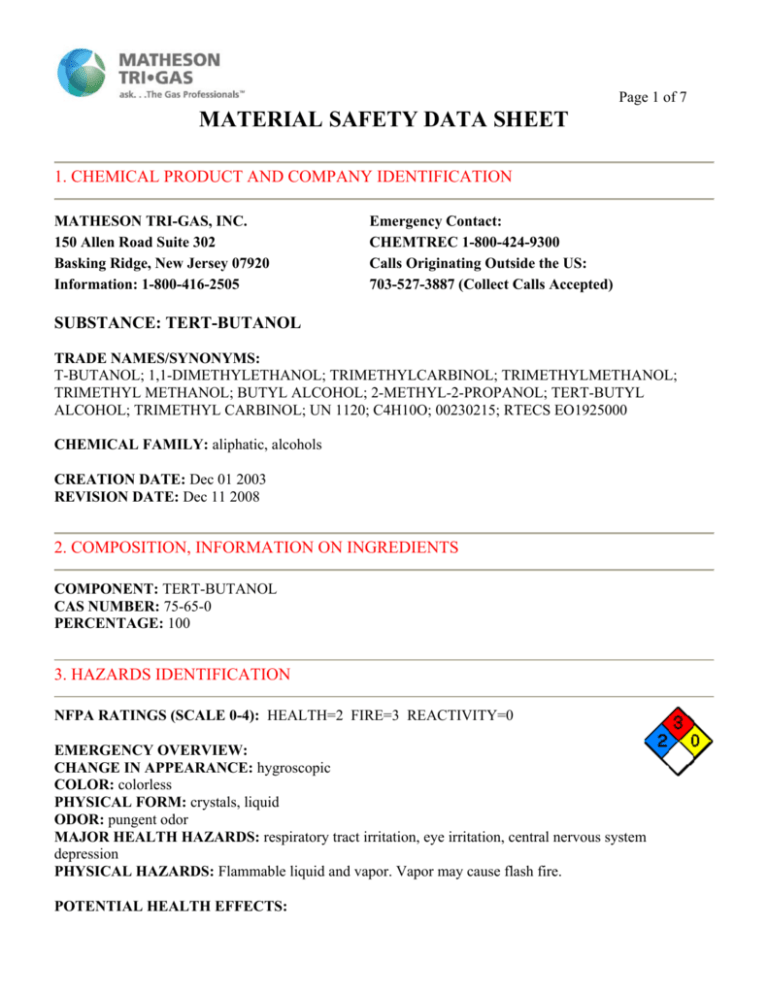
Page 1 of 7
MATERIAL SAFETY DATA SHEET
1. CHEMICAL PRODUCT AND COMPANY IDENTIFICATION
MATHESON TRI-GAS, INC.
150 Allen Road Suite 302
Basking Ridge, New Jersey 07920
Information: 1-800-416-2505
Emergency Contact:
CHEMTREC 1-800-424-9300
Calls Originating Outside the US:
703-527-3887 (Collect Calls Accepted)
SUBSTANCE: TERT-BUTANOL
TRADE NAMES/SYNONYMS:
T-BUTANOL; 1,1-DIMETHYLETHANOL; TRIMETHYLCARBINOL; TRIMETHYLMETHANOL;
TRIMETHYL METHANOL; BUTYL ALCOHOL; 2-METHYL-2-PROPANOL; TERT-BUTYL
ALCOHOL; TRIMETHYL CARBINOL; UN 1120; C4H10O; 00230215; RTECS EO1925000
CHEMICAL FAMILY: aliphatic, alcohols
CREATION DATE: Dec 01 2003
REVISION DATE: Dec 11 2008
2. COMPOSITION, INFORMATION ON INGREDIENTS
COMPONENT: TERT-BUTANOL
CAS NUMBER: 75-65-0
PERCENTAGE: 100
3. HAZARDS IDENTIFICATION
NFPA RATINGS (SCALE 0-4): HEALTH=2 FIRE=3 REACTIVITY=0
EMERGENCY OVERVIEW:
CHANGE IN APPEARANCE: hygroscopic
COLOR: colorless
PHYSICAL FORM: crystals, liquid
ODOR: pungent odor
MAJOR HEALTH HAZARDS: respiratory tract irritation, eye irritation, central nervous system
depression
PHYSICAL HAZARDS: Flammable liquid and vapor. Vapor may cause flash fire.
POTENTIAL HEALTH EFFECTS:
Page 2 of 7
INHALATION:
SHORT TERM EXPOSURE: irritation, nausea, vomiting, difficulty breathing, headache, drowsiness,
dizziness, loss of coordination, blurred vision
LONG TERM EXPOSURE: no information on significant adverse effects
SKIN CONTACT:
SHORT TERM EXPOSURE: irritation
LONG TERM EXPOSURE: irritation
EYE CONTACT:
SHORT TERM EXPOSURE: irritation, blurred vision
LONG TERM EXPOSURE: irritation
INGESTION:
SHORT TERM EXPOSURE: nausea, vomiting, diarrhea, stomach pain, headache, drowsiness, dizziness,
loss of coordination, unconsciousness
LONG TERM EXPOSURE: no information on significant adverse effects
4. FIRST AID MEASURES
INHALATION: If adverse effects occur, remove to uncontaminated area. Give artificial respiration if not
breathing. If breathing is difficult, oxygen should be administered by qualified personnel. Get immediate
medical attention.
SKIN CONTACT: Wash skin with soap and water for at least 15 minutes while removing contaminated
clothing and shoes. Get medical attention, if needed. Thoroughly clean and dry contaminated clothing and
shoes before reuse.
EYE CONTACT: Flush eyes with plenty of water for at least 15 minutes. Then get immediate medical
attention.
INGESTION: If a large amount is swallowed, get medical attention.
NOTE TO PHYSICIAN: For inhalation, consider oxygen.
5. FIRE FIGHTING MEASURES
FIRE AND EXPLOSION HAZARDS: Severe fire hazard. The vapor is heavier than air. Vapors or gases
may ignite at distant ignition sources and flash back. Vapor/air mixtures are explosive.
EXTINGUISHING MEDIA: alcohol-resistant foam, carbon dioxide, regular dry chemical, water
Large fires: Use alcohol-resistant foam or flood with fine water spray.
FIRE FIGHTING: Move container from fire area if it can be done without risk. Dike for later disposal. Do
not scatter spilled material with high-pressure water streams. Cool containers with water spray until well
after the fire is out. Stay away from the ends of tanks. Withdraw immediately in case of rising sound from
Page 3 of 7
venting safety device or any discoloration of tanks due to fire. For tank, rail car or tank truck, evacuation
radius: 800 meters (1/2 mile). Do not attempt to extinguish fire unless flow of material can be stopped first.
Flood with fine water spray. Do not scatter spilled material with high-pressure water streams. Cool
containers with water spray until well after the fire is out. Apply water from a protected location or from a
safe distance. Avoid inhalation of material or combustion by-products. Stay upwind and keep out of low
areas.
FLASH POINT: 52 F (11 C) (CC)
LOWER FLAMMABLE LIMIT: 2.4%
UPPER FLAMMABLE LIMIT: 8.0%
AUTOIGNITION: 892 F (478 C)
FLAMMABILITY CLASS (OSHA): IB
6. ACCIDENTAL RELEASE MEASURES
OCCUPATIONAL RELEASE:
Avoid heat, flames, sparks and other sources of ignition. Remove sources of ignition. Stop leak if possible
without personal risk. Reduce vapors with water spray. Small spills: Absorb with sand or other noncombustible material. Collect spilled material in appropriate container for disposal. Large spills: Dike for
later disposal. Keep unnecessary people away, isolate hazard area and deny entry. Stay upwind and keep out
of low areas.
7. HANDLING AND STORAGE
STORAGE: Store and handle in accordance with all current regulations and standards. Subject to storage
regulations: U.S. OSHA 29 CFR 1910.106. Grounding and bonding required. Keep separated from
incompatible substances.
8. EXPOSURE CONTROLS, PERSONAL PROTECTION
EXPOSURE LIMITS:
TERT-BUTANOL:
TERT-BUTYL ALCOHOL:
100 ppm (300 mg/m3) OSHA TWA
150 ppm (450 mg/m3) OSHA STEL (vacated by 58 FR 35338, June 30, 1993)
100 ppm ACGIH TWA
100 ppm (300 mg/m3) NIOSH recommended TWA 10 hour(s)
150 ppm (450 mg/m3) NIOSH recommended STEL
VENTILATION: Ventilation equipment should be explosion-resistant if explosive concentrations of
material are present. Provide local exhaust ventilation system. Ensure compliance with applicable exposure
limits.
Page 4 of 7
EYE PROTECTION: Wear splash resistant safety goggles with a faceshield. Provide an emergency eye
wash fountain and quick drench shower in the immediate work area.
CLOTHING: Wear appropriate chemical resistant clothing.
GLOVES: Wear appropriate chemical resistant gloves.
RESPIRATOR: The following respirators and maximum use concentrations are drawn from NIOSH and/or
OSHA.
1600 ppm
Any supplied-air respirator operated in a continuous-flow mode.
Any powered, air-purifying respirator with organic vapor cartridge(s).
Any air-purifying respirator with a full facepiece and an organic vapor canister.
Any air-purifying full-facepiece respirator (gas mask) with a chin-style, front-mounted or back-mounted
organic vapor canister.
Any self-contained breathing apparatus with a full facepiece.
Any supplied-air respirator with a full facepiece.
Emergency or planned entry into unknown concentrations or IDLH conditions Any self-contained breathing apparatus that has a full facepiece and is operated in a pressure-demand or
other positive-pressure mode.
Any supplied-air respirator with a full facepiece that is operated in a pressure-demand or other positivepressure mode in combination with an auxiliary self-contained breathing apparatus operated in pressuredemand or other positive-pressure mode.
Escape Any air-purifying full-facepiece respirator (gas mask) with a chin-style, front-mounted or back-mounted
organic vapor canister.
Any appropriate escape-type, self-contained breathing apparatus.
9. PHYSICAL AND CHEMICAL PROPERTIES
PHYSICAL STATE: liquid
COLOR: colorless
CHANGE IN APPEARANCE: hygroscopic
PHYSICAL FORM: crystals, liquid
ODOR: pungent odor
MOLECULAR WEIGHT: 74.12
MOLECULAR FORMULA: (C-H3)3-C-O-H
BOILING POINT: 180 F (82 C)
MELTING POINT: 79 F (26 C)
VAPOR PRESSURE: 31 mmHg @ 20 C
VAPOR DENSITY (air=1): 2.6
SPECIFIC GRAVITY (water=1): 0.7887
WATER SOLUBILITY: soluble
PH: Not available
VOLATILITY: Not available
ODOR THRESHOLD: 73 ppm
Page 5 of 7
EVAPORATION RATE: 1.05 (butyl acetate=1)
VISCOSITY: 3.3 cP @ 30 C
COEFFICIENT OF WATER/OIL DISTRIBUTION: Not available
SOLVENT SOLUBILITY:
Soluble: alcohol, ether, acetone, benzene
10. STABILITY AND REACTIVITY
REACTIVITY: Stable at normal temperatures and pressure.
CONDITIONS TO AVOID: Avoid heat, flames, sparks and other sources of ignition. Containers may
rupture or explode if exposed to heat.
INCOMPATIBILITIES: metals, acids, oxidizing materials, combustible materials, metal salts
HAZARDOUS DECOMPOSITION:
Thermal decomposition products: oxides of carbon
POLYMERIZATION: Will not polymerize.
11. TOXICOLOGICAL INFORMATION
TERT-BUTANOL:
IRRITATION DATA: 500 ul/24 hour(s) skin-rabbit mild; 100 ul/24 hour(s) eyes-rabbit severe
TOXICITY DATA: >10000 ppm/4 hour(s) inhalation-rat LC50; >2 gm/kg skin-rabbit LD50; 2743 mg/kg
oral-rat LD50
CARCINOGEN STATUS: ACGIH: A4 -Not Classifiable as a Human Carcinogen
LOCAL EFFECTS:
Irritant: inhalation, eye
ACUTE TOXICITY LEVEL:
Moderately Toxic: ingestion
TARGET ORGANS: central nervous system
MEDICAL CONDITIONS AGGRAVATED BY EXPOSURE: kidney disorders, liver disorders,
respiratory disorders, skin disorders and allergies
TUMORIGENIC DATA: Available.
MUTAGENIC DATA: Available.
REPRODUCTIVE EFFECTS DATA: Available.
ADDITIONAL DATA: Alcohol may enhance the toxic effects.
12. ECOLOGICAL INFORMATION
ECOTOXICITY DATA:
FISH TOXICITY: 6410000 ug/L 96 hour(s) LC50 (Mortality) Fathead minnow (Pimephales promelas)
Page 6 of 7
INVERTEBRATE TOXICITY: 5504000 ug/L 48 hour(s) EC50 (Immobilization) Water flea (Daphnia
magna)
OTHER TOXICITY: 2450000 ug/L 48 hour(s) LC50 (Mortality) Clawed toad (Xenopus laevis)
13. DISPOSAL CONSIDERATIONS
Dispose in accordance with all applicable regulations. Subject to disposal regulations: U.S. EPA 40 CFR 262.
Hazardous Waste Number(s): D001.
14. TRANSPORT INFORMATION
U.S. DOT 49 CFR 172.101:
PROPER SHIPPING NAME: Butanols
ID NUMBER: UN1120
HAZARD CLASS OR DIVISION: 3
PACKING GROUP: II
LABELING REQUIREMENTS: 3
CANADIAN TRANSPORTATION OF DANGEROUS GOODS:
SHIPPING NAME: Butanols
UN NUMBER: UN1120
CLASS: 3
PACKING GROUP/CATEGORY: II
15. REGULATORY INFORMATION
U.S. REGULATIONS:
CERCLA SECTIONS 102a/103 HAZARDOUS SUBSTANCES (40 CFR 302.4): Not regulated.
SARA TITLE III SECTION 302 EXTREMELY HAZARDOUS SUBSTANCES (40 CFR 355 Subpart
B): Not regulated.
SARA TITLE III SECTION 304 EXTREMELY HAZARDOUS SUBSTANCES (40 CFR 355 Subpart
C): Not regulated.
SARA TITLE III SARA SECTIONS 311/312 HAZARDOUS CATEGORIES (40 CFR 370 Subparts B
and C):
ACUTE: Yes
CHRONIC: No
FIRE: Yes
REACTIVE: No
Page 7 of 7
SUDDEN RELEASE: No
SARA TITLE III SECTION 313 (40 CFR 372.65):
TERT-BUTYL ALCOHOL
OSHA PROCESS SAFETY (29 CFR 1910.119): Not regulated.
STATE REGULATIONS:
California Proposition 65: Not regulated.
CANADIAN REGULATIONS:
WHMIS CLASSIFICATION: Not determined.
NATIONAL INVENTORY STATUS:
U.S. INVENTORY (TSCA): Listed on inventory.
TSCA 12(b) EXPORT NOTIFICATION: Not listed.
CANADA INVENTORY (DSL/NDSL): Not determined.
16. OTHER INFORMATION
“RTECS®” is a United States trademark owned and licensed under authority of the U.S. Government, by
and through Symyx Software, Inc. Portions ©Copyright 2001, U.S. Government. All rights reserved.
©Copyright 1984-2009 ChemADVISOR, Inc. All rights reserved.
MATHESON TRI-GAS, INC. MAKES NO EXPRESS OR IMPLIED WARRANTIES,
GUARANTEES OR REPRESENTATIONS REGARDING THE PRODUCT OR THE
INFORMATION HEREIN, INCLUDING BUT NOT LIMITED TO ANY IMPLIED WARRANTY
OF MERCHANTABILITY OR FITNESS FOR USE. MATHESON TRI-GAS, INC. SHALL NOT BE
LIABLE FOR ANY PERSONAL INJURY, PROPERTY OR OTHER DAMAGES OF ANY NATURE,
WHETHER COMPENSATORY, CONSEQUENTIAL, EXEMPLARY, OR OTHERWISE,
RESULTING FROM ANY PUBLICATION, USE OR RELIANCE UPON THE INFORMATION
HEREIN.

